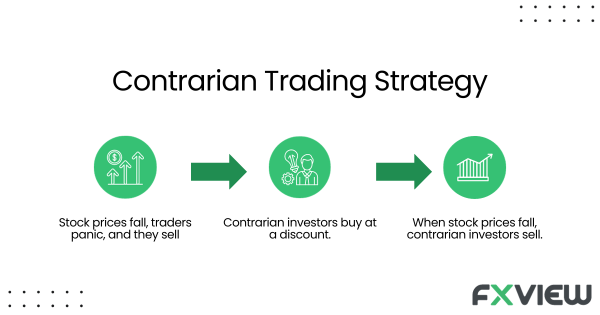
What is a Contrarian Trading Strategy?
In the high-speed realm of trading and investment, where shifts in trends and sentiments occur in the blink of an eye, there exists a strategy that piques curiosity and stands out for its distinctive approach – the Contrarian Trading Strategy. Stick around as we shed light on this strategy and discover why it might be considered an important tool for traders.
What is the Contrarian Trading Strategy?
A contrarian trading strategy involves investing and trading against market sentiment. It’s based on the idea that when the majority of market participants are bullish (expecting prices to potentially rise), it might be time to consider selling, and vice versa. Contrarian traders have this belief that emotions in the market might lead to exaggerated movements, and that’s where they see opportunities to make some potential.
Illustrative examples of Contrarian Trading Strategy
- The Fearful Sell-Off: Imagine a situation where a highly regarded tech stock experiences a sudden and sharp decline in its price due to a negative news article. The contrarian trader, instead of joining the panicked sellers, might see this as a potential opportunity to buy the stock at a discounted price, anticipating that the fear-driven sell-off is temporary.
- The Euphoric Rally: During a market bull run, when euphoria is driving prices to new highs, a contrarian trader might start considering the possibility of a correction. They could begin to scale back their positions or even initiate short trades, expecting that the market’s optimism is reaching unsustainable levels.
How does the Contrarian Trading Strategy work?
Contrarian trading involves thorough analysis and a keen understanding of market psychology. Here’s how it works:
- Identifying Extremes: Contrarian traders scan the market for situations where the majority sentiment is potentially bullish or bearish. This could involve analyzing technical indicators, sentiment gauges, and news events that might have caused an emotional reaction.
- Questioning the Consensus: Instead of blindly following the crowd, contrarian traders ask critical questions. They want to know if the current sentiment lines up with the actual fundamentals of the asset. If it doesn’t, they might see a potential opportunity for a contrarian move.
- Risk Management: Contrarian trading doesn’t mean recklessly going against the trend. Position sizes and stop-loss orders may be calculated to limit potential losses if the market sentiment persists.
- Patience and Timing: Contrarian trading requires patience. The trader waits for indications of the crowd’s sentiment beginning to shift or for technical indicators to show potential reversals. Timing is key, as entering a contrarian trade too early can result in losses.

Pros and Cons of the Contrarian Trading Strategy
Pros:
- Potential Gain from Market Overreactions: By going against the crowd, contrarian traders can capitalize on emotional market overreactions, potentially leading to favorable price reversals.
- Low Entry Points: Contrarian trades often involve buying assets at lower prices during market pessimism, enabling traders to enter positions at a discount.
- Diversification: Contrarian trading adds diversity to a trader’s portfolio, as it may thrive in markets where other strategies might struggle.
- Long-Term Value: Underperforming assets with sound fundamentals might rebound over time, offering long-term value to contrarian investors.
- Independent Thinking: Contrarian strategy encourages critical thinking and independence by challenging conventional wisdom.
Cons:
- Timing Challenges: Accurate timing is crucial; entering a contrarian trade too early or too late can lead to losses.
- Risk of Further Decline: Assets with negative sentiment might continue to underperform, leading to additional losses for contrarian traders.
- Lack of Indications: Contrarian trades might lack signs from technical indicators, increasing the risk of false signals.
- Emotional Stress: Going against prevailing sentiment can be emotionally challenging, causing stress and self-doubt.
- Limited Market Conditions: A Contrarian strategy is effective during extreme sentiment shifts but might not work well in trending markets.
Conclusion
Contrarian trading strategy summons the traditional wisdom of “following the crowd” and may open the door to potential opportunities. By capitalizing on emotional market overreactions, contrarian traders may take advantage of price reversals that others might have missed. It necessitates a solid knowledge of market psychology, thorough research, and perfect timing.
In the ever-evolving trading landscape, a contrarian trading strategy may serve as a reminder that markets can be as much driven by human emotions as they are by data and analysis. By daring to be different and going against the grain, contrarian traders can potentially gain a new perspective on market behavior.
Always remember, in the world of trading, sometimes it may be challenging to zag when others zag. Embracing the contrarian trading strategy mindset and making informed choices can potentially turn market sentiment to your advantage. However, bear in mind that there is always a high risk for potential losses, like all trading strategies, therefore you should always take into consideration your ability to bear the potential losses.
Disclaimer: The information contained in this article is provided for educational and informational purposes only and it is not intended to be, nor does it constitute financial, investment, or trading advice. You should not make any financial, investment, or trading decisions based on the information provided in this article without performing your own research or seeking advice from an independent advisor.



